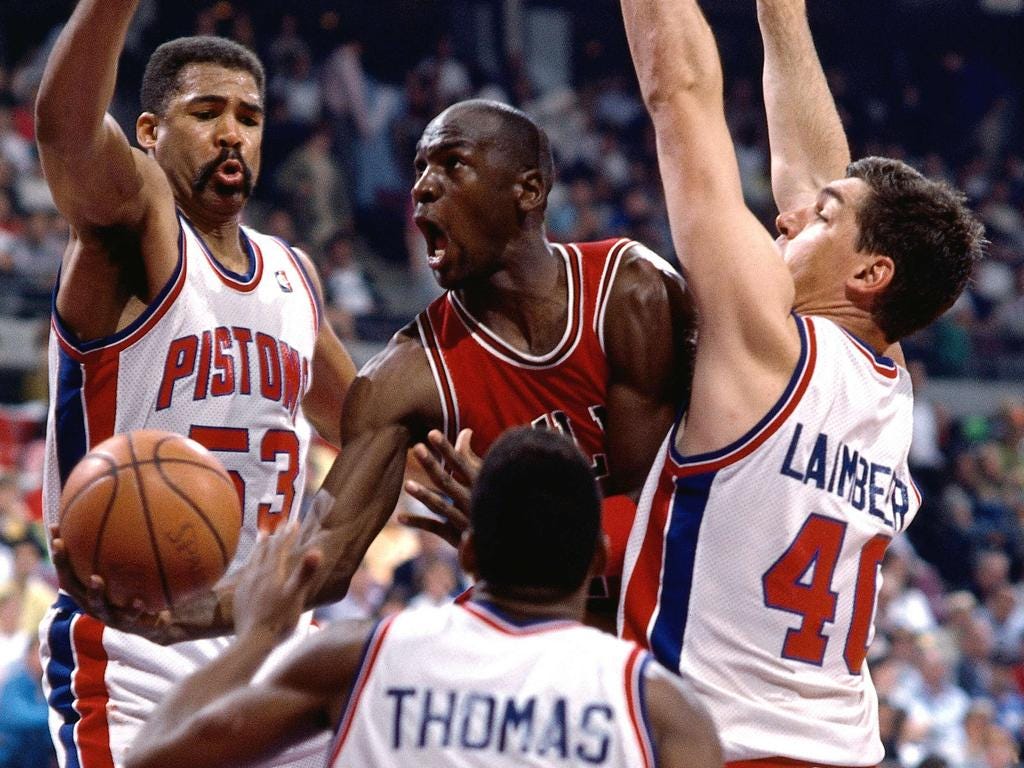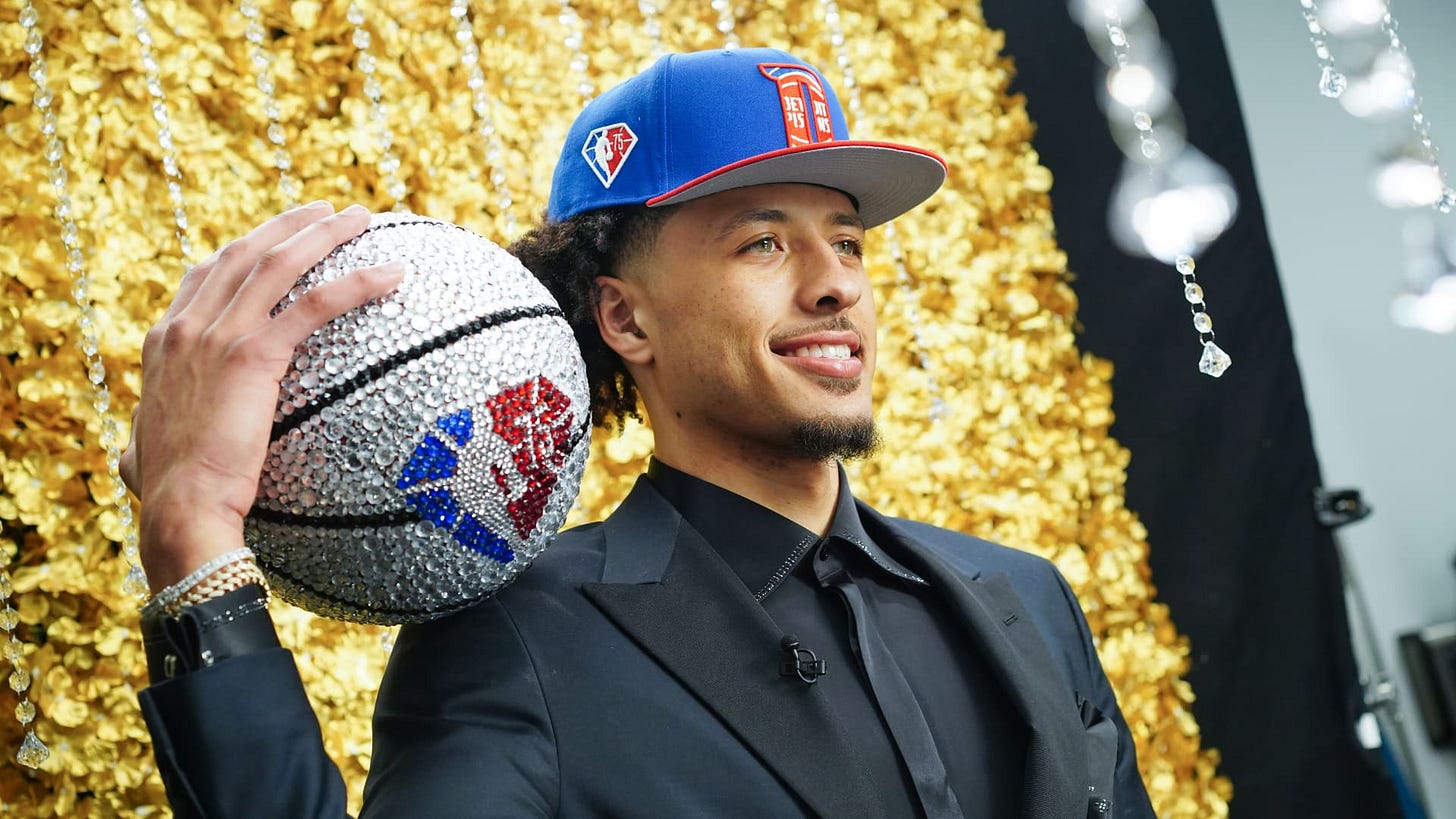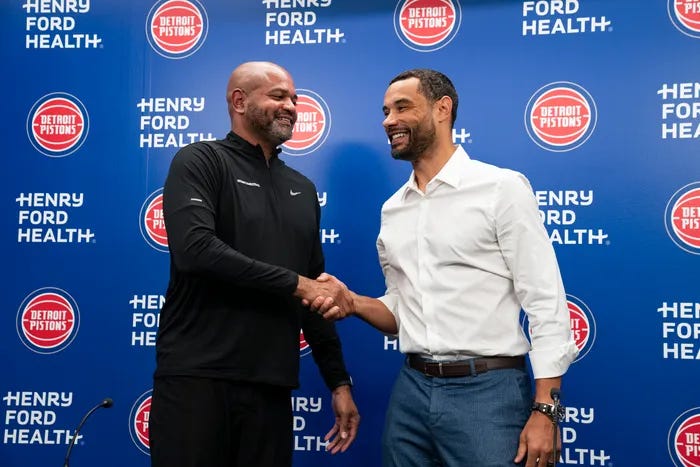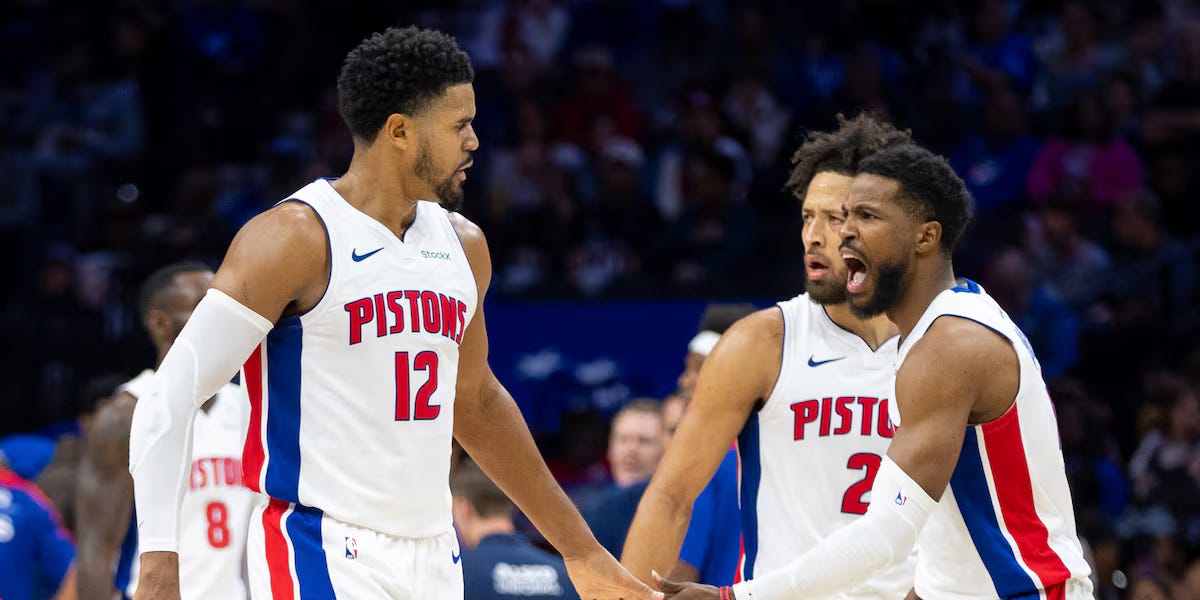The Bad Boys are Back
From rock bottom to resurgence: How the Detroit Pistons rebuilt their identity and became a rising force in the NBA.
Last season, the Detroit Pistons endured one of the worst campaigns in NBA history, finishing with a dismal 14-68 record. Their struggles were highlighted by a historic 28-game losing streak, the longest in league history. Unfortunately, this level of failure had become all too familiar for Pistons fans—it marked the franchise’s fifth consecutive season with fewer than 20 wins and their 13th losing season in 14 years.
Yet, it wasn't always this way. The Pistons were once a dominant force in the NBA. In the late 1980s, the "Bad Boy Pistons" were born, led by five future Hall of Famers: Isiah Thomas, Dennis Rodman, Mark Aguirre, Joe Dumars, and Bill Laimbeer. They weren’t just talented—they were relentless. Known for their physical, aggressive, and often controversial style of play, the Bad Boys embraced their reputation from 1986 to 1992. This hard-nosed identity propelled them to back-to-back championships in 1989 and 1990, and they came within a game of another title in 1988 before Isiah Thomas suffered a severe ankle injury. Ultimately, it took Michael Jordan’s rise to end their reign.
Fifteen years later, in 2004, a new era of Pistons basketball emerged. Detroit stunned the NBA world by defeating the powerhouse Los Angeles Lakers, led by Kobe Bryant and Shaquille O’Neal, to win the championship. The team, headlined by Chauncey Billups, Ben Wallace, Rasheed Wallace, and Rip Hamilton, revived the franchise’s signature toughness. From 2002 to 2008, the Pistons made six consecutive Eastern Conference Finals appearances, reaching the NBA Finals twice and solidifying themselves as an Eastern Conference juggernaut.
But when that core separated in 2008, the franchise spiraled. Detroit made the playoffs only three times over the next 15 years—and was swept each time. Poor drafting, bad coaching, and mismanagement turned the Pistons into an afterthought.
That is, until now. The tide has turned in Detroit. The Pistons currently boast a 37-29 record with one of the youngest, most athletic, and most promising rosters in the NBA. The Bad Boys are back. Let’s dive into how Detroit clawed its way back from rock bottom.
Building Through the Draft (2021-2022)
Rather than revisiting every mistake the Pistons made throughout the 2010s, let’s focus on where their turnaround truly began. On June 18, 2020, the franchise hired Troy Weaver as general manager, signaling a new direction. Detroit finished the following season 20-52, which landed them the first overall pick in the 2021 NBA Draft.
With that selection, they secured Cade Cunningham, a 6’8” point guard from Oklahoma State, who had averaged 20.1 points, 6.2 rebounds, and 3.5 assists in college. Cunningham was the consensus best player in the country, and Detroit hoped they were landing their franchise player. Detroit also acquired Isaiah Stewart with the 16th selection in the 2020 draft. The 6’8”, 250-pound forward made up for his raw skill with sheer tenacity, embodying the franchise’s old-school toughness.
Cunningham’s rookie campaign was impressive: 17.4 points, 5.5 rebounds, and 5.6 assists per game, along with solid defensive contributions. However, he lacked a supporting cast. Other than bullying opponents, Stewart wasn’t much help, and the rest of the Pistons team was a confused mess. Detroit finished 23-59, earning the fifth pick in the 2022 Draft.
With that pick, they selected Jaden Ivey, an electrifying guard, to pair with Cunningham. Later in the first round, Detroit traded with the Knicks to acquire Jalen Duren, a 6’10”, 250-pound powerhouse center from Memphis. Both rookies showed promise, but the team still struggled, finishing the 2022-23 season with a 17-65 record. Despite the losses, the Pistons had assembled a promising young core.
Developing Young Talent (2021-2023)
Throwing young players into the fire of NBA competition isn’t always a recipe for success, but for the Pistons, it was necessary. While Weaver excelled at drafting talent, he struggled to build through trades and free agency, leaving Cunningham, Ivey, and Duren with no choice but to learn through experience.
Cunningham made the biggest leap. Over three seasons, his points per game increased by three each year, while his assists rose from 5.6 to 7.5. His shooting percentages also improved, with a 4.4% increase from three-point range and a 3.3% boost from the field. Despite a 12-game sophomore season due to injury, his development was undeniable. By the 2023-24 season, he averaged 22.7 points, 7.5 assists, and 4.3 rebounds per game, proving himself as one of the NBA’s brightest young stars.
Ivey and Duren’s progress was steadier but equally important. Ivey quickly found his role as Cunningham’s backcourt partner, averaging 16.3 points and 5.2 assists per game in his rookie season, and maintaining those numbers in his second year. Duren, meanwhile, developed into a force in the paint, posting 13.8 points and 11.6 rebounds per game in his second season, showcasing his potential as a dominant big man.
Selecting Ausar Thompson (2023 Draft)
With the fifth pick in the 2023 Draft, Detroit selected Ausar Thompson from the Overtime Elite developmental league—a controversial move at the time. Critics questioned his shooting ability and readiness for the NBA, but the Pistons had a plan.
Thompson was one of the most explosive athletes the draft had ever seen. His 2.2 blocks per game at just 6’6” hinted at immense defensive upside. More importantly, he had the potential to revive the Pistons’ identity as a gritty, defensive-minded team. Within months, he established himself as one of the NBA’s best on-ball defenders, proving Detroit’s faith in him was well-placed.
Management and Roster Changes
Despite their promising young core, the Pistons needed veterans who could provide shooting and experience. Weaver’s failure to build a proper supporting cast had stunted the team’s growth, leading ownership to part ways with him in 2024. Enter Trajan Langdon, a seasoned executive with a track record of building competitive teams.
Langdon’s first move was hiring J.B. Bickerstaff, fresh off a successful tenure in Cleveland, where he transformed the Cavaliers from a lottery team into a playoff mainstay. With coaching stability in place, Langdon turned his attention to the offseason.
2024 Free Agency and Draft
Detroit had several deficiencies heading into the 2024 off-season. First, a lack of shooting. Detroit was near the bottom of the league in every shooting metric, especially 3-point shooting. Second, a lack of veteran leadership —Detroit had the third youngest team in the 2023-2024 season.
Detroit solved both of those issues with every signing they made in free agency. They signed Malik Beasley, Tim Hardaway Jr., and Tobias Harris, all seasoned veterans shooting above 35% from three. Many scoffed at these signings, thinking that the Pistons were grabbing players from the bottom of the free agency barrel. But they had a vision.
In the 2024 Draft, Detroit selected Ron Holland from the G-League Ignite with the fifth pick. Like Thompson the year before, Holland was seen as a raw talent, but his athleticism, defensive intensity, and relentless motor made him an ideal fit for the Pistons’ new identity.
The Results
The Pistons’ transformation in the 2024-25 season has been nothing short of remarkable. The young core has developed into legitimate stars, the veteran additions have provided much-needed stability, and the franchise’s identity—rooted in defense, toughness, and unrelenting energy—has been restored. After years of poor management and missed opportunities, Detroit finally has a cohesive roster built for success.
A key part of this resurgence has been the development of the Cunningham-Ivey-Duren trio, whose growth has elevated the team from a rebuilding project to a legitimate playoff contender. Cunningham has transformed into a future MVP candidate, as a better-supporting cast has highlighted his playmaking ability. Ivey has become the perfect second option to Cade, and Duren now commands the offense from the middle.
The contributions from the new signings have also been vital, as their shooting and experience have provided the balance that was previously missing. Notably, Malik Beasley is putting up the best numbers of his career and has the second best odds at winning sixth man of the year.
Perhaps most importantly, the Pistons have rediscovered what made them great in the past — owning the “Bad Boys” style. Ausar Thompson, Isaiah Stewart, and Ron Holland have created a hard-nosed, defensive-minded approach that embodies the spirit of the city. They hound ballhandlers, scream in opponents’ faces, and are ready to go toe-to-toe with anyone.
Detroit is no longer a bottom feeder or an afterthought. They are young, hungry, and built to compete now and in the future. The Bad Boys are back, and this time, they’re here to stay. The NBA is a better place when the Pistons are good.
If you’ve been noticing fewer articles on this page, it’s because I’ve been working on other projects!
Go check out my videos on TikTok, and my articles on FanSided and CelticsBlog! All linked below:
https://www.tiktok.com/@beyondtheboxscore_










